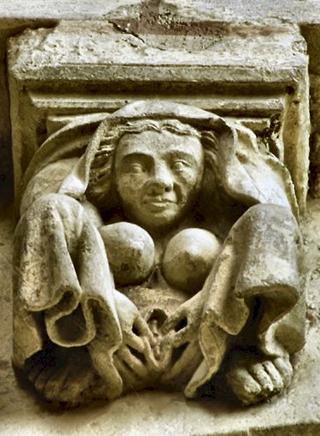February 1st, 2010 -- by Bacchus
Explicit Medieval Corbel
I have seen references on the Web (sadly, they are aren’t coming before my eyes just now) to the fact that early Medieval churches in Europe often contained startlingly explicit sexual material in the carvings and ornate stone decorations. I don’t have a source for this picture, but I wonder if it isn’t an example:

Similar Sex Blogging:
This entry was posted on Monday, February 1st, 2010 at 12:04 am. You can follow any responses to this entry through the RSS 2.0 feed. You can skip to the end and leave a response.
Shorter URL for sharing: https://www.erosblog.com/?p=4521
Shorter URL for sharing: https://www.erosblog.com/?p=4521








There are variations in the spelling, but it’s commonly known as a Sheela na Gig. They are usually found on churches, and there are over a hundred in Ireland alone. The most common thinking is that they are good luck charms, grown from the belief that a woman can repel evil by lifting her skirts and showing a demon that mysterious gateway between life and “non-life”…
I agree with Dr Whiplash and saw a number of these items when I visited Ireland in 2003. There is a web-site that lists (with pictures) all the Sheela na Gig in Ireland. It is http://www.irel...hive/
Note the main site is undergoing renovation and this is the archive.
There was, in 2003, an example in the National Museum Dublin on open display, and there are a number of books available on the subject from the Museum shop.
Is this perhaps the origin of the skirt-lifting antics in DragonBall Z? Or is it because the women don’t get that much airtime and want more attention?
Did you get it from this Greek site: http://sfrang2.....html
Here’s Google’s translation: http://tinyurl....dns8t
Sheela na Gig, eh?
I found this very interesting and quickly did a web search on the term. There are a number of sites devoted to these sculptures and their cultural significance.
The thing I found interesting is that most of the Irish and British sculptures are quite primitive or abstract (take your pick). However, the picture posted here is not at all abstract and is in fact quite voluptuous and earthy. I wonder where this particular sculpture is located?
Dave, I didn’t get it from that site, but it’s certainly there, thanks for the link.
A nice collection:
http://blog.cla...roman
I think the best is to paraphrase an old antedote
‘A man is given life, he leaves the woumb, to discover he liked it. Then spends the rest of his life trying to find another.’
Faith is believing your search will be rewarded.